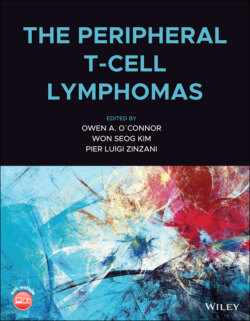Читать книгу The Peripheral T-Cell Lymphomas - Группа авторов - Страница 40
Other Factors
ОглавлениеOnly few physical factors have been identified as underlying factors favoring T‐cell lymphoma development. Analyses of mutational signatures derived from whole genome sequencing revealed that enrichment in ultraviolet radiation‐induced signature in CTCL are, suggesting that ultraviolet radiation could contribute to CTCL [106].
The role of mutations in epigenetic regulators which occur at high frequency in hematopoietic progenitor cells (see section 2.2.1.1 Signaling Pathways) is still unclear. Beside changes in the gene expression levels induced by epigenetic alterations in the regulatory regions, these mutations could induce some genomic instability, subsequently favoring the acquisition of additional mutations that could drive the tumor transformation. It has been recently postulated that TET2, IDH2, and DNMT3A could induce some degrees of genomic instability by various pathway. Mutations in IDH1/2 could also result, via the production of the oncometabolite D‐2 hydroxyglutarate, in impaired DNA repair, which could have therapeutic consequences [107, 108]. Alterations in TET proteins could also increase DNA damage [109, 110].
Few predisposing factors of PTCL development have been identified in population studies. In addition to HLA‐DPB1 association with NKTCL which could explain geographic differences in NKTCL incidence (see above), a germline HAVCR2 mutation altering TIM‐3 has been reported in around 60% of patients with subcutaneous panniculitis‐like T‐cell lymphoma [111].
